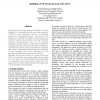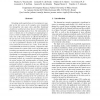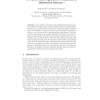142
click to vote
P2PKM
2004
15 years 2 months ago
2004
Peer-to-Peer (P2P) systems share and manage huge amounts of data and resources distributed across a large number of machines. In pure P2P environments the control is totally decent...
112
Voted
EDBT
2008
ACM
15 years 2 months ago
2008
ACM
Testing peer-to-peer (P2P) systems is difficult because of the high numbers of nodes which can be heterogeneous and volatile. A test case may be composed of several ordered action...
127
Voted
VLDB
2001
ACM
15 years 5 months ago
2001
ACM
“Peer-to-peer” systems like Napster and Gnutella have recently become popular for sharing information. In this paper, we study the relevant issues and tradeoffs in designing a...
88
Voted
P2P
2002
IEEE
15 years 5 months ago
2002
IEEE
Decentralized file-sharing systems like Napster [11] and Gnutella [23] have popularized the peer-to-peer approach [18,20,22], which emphasizes the use of distributed resources in ...
112
click to vote
DBISP2P
2003
Springer
15 years 5 months ago
2003
Springer
In this paper we give a robust logical and computational characterisation of peer-to-peer (p2p) database systems. We first define a precise model-theoretic semantics of a p2p sys...
108
click to vote
LAWEB
2003
IEEE
15 years 5 months ago
2003
IEEE
Streaming media applications are becoming more popular on the late years, as for example, news transmitted live through the web, music, show, and films. Traditional client/server...
126
click to vote
VECPAR
2004
Springer
15 years 6 months ago
2004
Springer
Peer-to-peer (P2P) computing offers new opportunities for building highly distributed data systems. Unlike client-server computing, P2P can operate without central coordination and...
GC
2004
Springer
15 years 6 months ago
2004
Springer
Abstract. Is it possible to treat large scale distributed systems as physical systems? The importance of that question stems from the fact that the behavior of many P2P systems is ...
96
Voted
GCC
2005
Springer
15 years 6 months ago
2005
Springer
In order to deal with free riding in P2P system, incentive mechanism or rating system is presented, and each user rating is computed by itself, which causes that some users exagger...
99
Voted
INFOSCALE
2006
ACM
15 years 6 months ago
2006
ACM
— When a P2P system has millions of concurrently active peers, there is the risk that it could serve as a DDoS engine for attacks against a targeted host. In this paper we descri...




